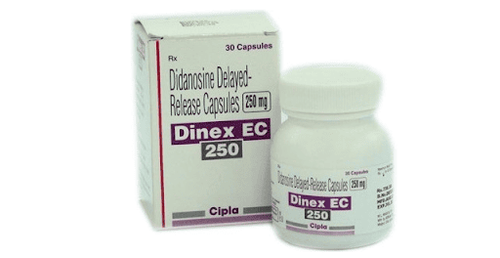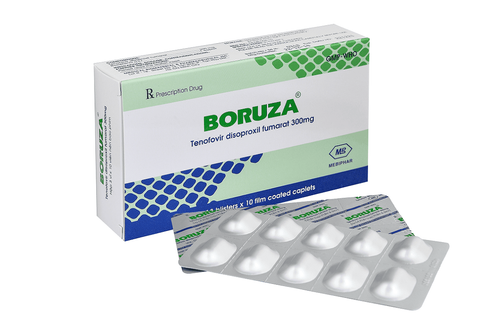This is an automatically translated article.
Pesatic drug with the main active ingredient is Tenofovir disoproxil fumarate, used for combination treatment in cases of HIV-type 1 infection, hepatitis caused by HBV and prophylaxis for people at high risk of HIV infection for adults.
1. What are the uses of Pestic?
Pestic medicine has the main ingredient is Tenofovir disoproxil fumarate with the strength of 300mg, which is prepared in the form of film-coated tablets.
Tenofovir disoproxil fumarate is structurally a helical nucleotide analogous to adenosine monophosphate, the prodrug of Tenofovir. After entering the body, it will be phosphorylated to the active diphosphate form, tenofovir diphosphate is active against the polymerase (reverse transcriptase) of HBV and HIV.
Thanks to that, this drug is effective against the replication and development of HIV and HBV viruses.
2. Indications and contraindications of Pestic
Indications:
Pestic is indicated for use in the following cases:
Chronic hepatitis B in adults: Treatment when there is evidence of active viral replication, histopathological evidence of active hepatitis or fibrosis. Combination of antiretroviral drugs for the prevention of HIV infection after exposure to HIV-infected patients in individuals at risk of viral infection. Combination with other antiretroviral drugs for the treatment of HIV. Contraindications:
Do not use Pestic if you are sensitive to the active ingredient tenofovir disoproxil fumarate or to any of its ingredients. Because the drug Pestic contains an excipient, Lactose, so you should not use this medicine if you have galactose intolerance, the syndrome of glucose or galactose malabsorption, the lactase deficiency.
3. Dosage and how to use Pestic
How to use: The drug is taken orally, when taking you swallow the tablet whole, do not chew or crush the tablet. To make sure you are taking this medication effectively, you should take it regularly and on time. This drug should be taken on a full stomach because taking it with food may help increase the bioavailability of tenofovir disoproxil fumarate.
Dosage:
HIV treatment: The dose of Pestic is 1 tablet, once a day. Must be used in combination with other antiretroviral drugs. Prophylaxis of post-exposure HIV infection with or without occupational causes preferably within a few hours, up to a maximum of 72 hours: Take 1 tablet x 1 time/day, in combination with other antiretroviral drugs; continue for 28 consecutive days. Chronic active hepatitis B in adults (age 18 years and older): The recommended dose is 1 tablet and taken once a day, taken on a full stomach. Renal Impairment: Dosage adjustment is required in patients with renal impairment. As tenofovir is eliminated by the kidneys, blood concentrations of tenofovir are increased in patients with renal impairment.
Patients with creatinine clearance ≥ 50 ml/min: Patients taking the drug at the recommended dose of 300 mg every 24 hours Patients with creatinine clearance between 30 - 49 ml/min: Take 300 mg (1 tablet) after every 48 hours. Patients with creatinine clearance between 10 - 29 ml/min: Take 300 mg (1 tablet) every 72 - 96 hours. People on hemodialysis: Take 300mg (1 tablet) every 7 days or after the total hemodialysis time is nearly 12 hours. Hepatic impairment: No dose adjustment is necessary in patients with hepatic impairment.
Children: Currently, it is not really clear the effectiveness and safety of the drug in patients under 18 years old, so it should not be used.
Elderly: Elderly: Clinical studies with tenofovir have not been conducted in patients 65 years of age or older to see if they respond differently from younger adults, so care should be taken when choosing a dose level. Fit.
Overdose: Symptoms of overdose have been reported including nausea and vomiting, skin rash, hypophosphataemia, acute renal failure, hepatic lactic acidosis. In case of overdose, the patient should be treated symptomatically and supportively.
4. Side effects of Pestic
When taking Pestic you may also experience side effects including:
Common such as nausea and vomiting, abdominal bloating, diarrhea, dyspepsia, loss of appetite; Uncommon side effects: lower blood phosphate levels; skin rash; There have been reports of cases of elevated liver enzymes, liver disease, increased blood triglycerides, increased blood sugar, neutropenia, nephritis, renal failure, acute renal failure and possibly tubular involvement. kidney; Poisoning by lactic acid, fatty liver, cirrhosis Other effects such as: Peripheral neuropathy, dizziness, insomnia, headache, depression, weakness, sweating; shortness of breath, bronchial asthma, excessive sweating, muscle aches. Other side effects not listed above may also occur. If you experience any side effects while using the drug, you should inform your doctor for the most appropriate advice.
5. Pay attention when using Pestic
To use the drug safely you need to keep the following in mind:
When taking Pestic for HIV or HBV, although antiretroviral therapy has been shown to significantly reduce the risk of STIs, but that doesn't rule out the small residual risk. Sexual transmission precautions still need to be taken according to guidelines. It is recommended that creatinine clearance and renal function be determined prior to initiating treatment with Pestic and closely monitored after 2 to 4 weeks of treatment, after 3 months of therapy, and every 3 to 6 months thereafter in patients without risk factors. In patients at risk of impaired renal function, more frequent monitoring of function is required. Avoid concomitant use of Pestic or near the time of taking known glomerular-toxic preparations such as aminoglycosides, foscarnet, ganciclovir, vancomycin, pentamidine, cidofovir or interleukin-2. But if concomitant use of tenofovir disoproxil fumarate and other Nephrotoxic agents cannot be avoided, patients should be monitored weekly renal function. Effects on bones: A slight decrease in bone density of the hips and spine has been observed. The decrease in bone density is increased with long-term use of the drug. Alternative regimens should be considered for patients with osteoporosis because of the high risk of fracture. When taking the drug may occur weight gain, increase in lipids and blood glucose. These changes may, however, be partly related to disease control and lifestyle changes. Evidence for weight gain is not clear, and increased lipids have been shown to be associated with the use of this drug. Monitoring of lipids and blood glucose should still be carried out according to HIV treatment guidelines. Dyslipidemia, if present, can be controlled by appropriate clinical measures. Liver disease: It has been found that a small number of patients who take the drug may experience more severe conditions than hepatitis. A flare of hepatitis may also occur during treatment, with manifestations after initiation of antiretroviral therapy, where serum GPT may be elevated in some patients, particularly in cirrhotic patients who may be at risk. patients with decompensated liver disease following an outbreak of hepatitis. Pestic therapy should be discontinued when aminotransferase levels increase rapidly, hepatomegaly increases, severe fatty liver, or metabolic acidosis or lactic acidosis of unknown cause. Outbreaks of Hepatitis After Discontinuation of Treatment: Acute flares of hepatitis have also been reported in studies in patients who discontinued hepatitis B therapy. Exacerbations after discontinuation of therapy have often been associated with HBV DNA levels increase and are in most cases self-limited. However, severe outbreaks, including fatal ones, have been reported. Liver function should be closely monitored at the time of drug discontinuation for at least 6 months after stopping hepatitis B treatment. If a flare-up occurs, patients can continue hepatitis B treatment, especially for those In patients with advanced liver disease or who already have cirrhosis, discontinuation of this drug is not recommended because flare-ups in cirrhotic patients after treatment may lead to hepatic decompensation. Osteonecrosis: This is a disease that can be considered to be caused by a variety of causes (including corticosteroid use, alcohol consumption, severely immunocompromised people, high body mass index) cases. Osteonecrosis has also been reported, particularly in patients with advanced HIV. Patients should consult a doctor if they experience symptoms of joint pain, stiffness or difficulty in movement. Due to the drug has undesirable effects such as headache, somnolence, dizziness, drowsiness. Therefore, patients should use caution when driving or operating machinery. Pregnancy and breast-feeding: Due to the lack of adequate studies, this drug should only be used if the potential benefit outweighs the risk to the fetus and should not be breast-feeding while taking this medicine.
6. Drug interactions
Some interactions have been reported including:
Other drugs containing tenofovir disoproxil fumarate or adefovir dipivoxil should not be combined; didanosine drugs should also not be combined Avoid the combination of Pesatic drugs with nephrotoxic drugs Interactions with drugs such as atazanavir/ritonavir, lopinavir/ritonavir, darunavir/ritonavir: Usually no dose adjustment is required when combined with pairs this drug. However, prompt assessment of renal function is required. Store Pestic medicine in a dry place, the storage temperature is below 30°C, protect from light and moisture. Note the location of the drug should be out of reach of children
Pastic medicine is an antiviral drug that is used under the direction of a doctor. To make sure you take this medicine safely and effectively, you need to follow your doctor's instructions exactly.
Follow Vinmec International General Hospital website to get more health, nutrition and beauty information to protect the health of yourself and your loved ones in your family.













